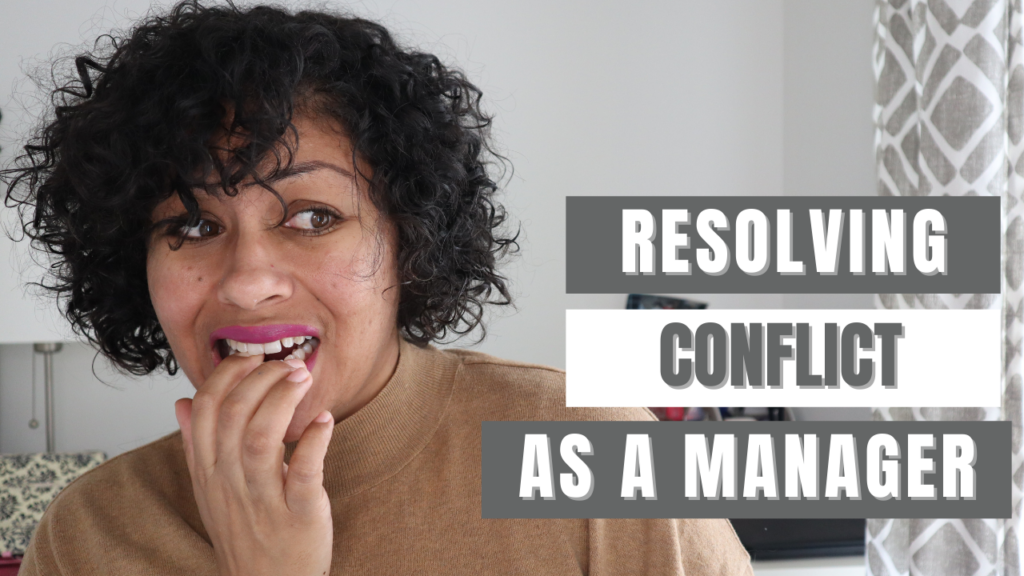(00:06):
Hopefully, you’re having a fantastic January today is the inauguration. And with all the turmoil happening between the two parties, it made me think about conflict, which we have to deal with in all aspects of our lives. It doesn’t matter if it’s at work, school with your family, with your friends, with strangers, it happens, and you have to learn how to deal with it. So when I was thinking about it, I was looking at the PMP because every year or every two years, it changes. So I got mine in 2015, and since then, there have been some changes. And one of the areas that I saw that had been added is managing conflicts within teams. And so I thought it would be a good idea to talk about it today. Hello, my name is Chavonne, and I talk about management productivity and organization.
(00:58):
And I do also discuss my time as an online grad student, as well as taking care of a baby with my busy schedule. So if you liked those types of videos, please consider subscribing to hitting the notification bell. So you’re notified also subscribing to my email newsletter, and let’s get started on talking about conflict. So why does conflict exist? There are multiple reasons by a conflict exists. The main one is personality clashes. We are not all carbon copies of one another. There will be differences in the way people think, the way they feel, and how they deal with a situation. And with that, there’s always going to be conflicting ways of doing that within the team and with your clients. And as I said, this can apply to any part of your life. And so that is one of the main reasons why conflict exists is the fact that two people have clashing personalities.
(01:59):
Other reasons why conflict exists could be schedule conflicts. It could be technical issues. People have competing priorities. And if they’re multiple stakeholders in one project, they can have competing priorities. And so that is another reason why conflict can exist. Other types of conflicts as well can be poor planning, um, issues with the contract. If you’re working with a team that is spread all over the country and or even the world, you can have, like, uh, cultural differences because even within us, someone from the North East coast is different from someone from the West coast. That could also be one of the reasons that there is conflict. Now, one thing is it’s all conflict terrible, and no, it isn’t. One of the things that are great about conflict is that it can spur innovation. And the reason why can help with innovation and is because you break apart, that sense of groupthink that can sometimes happen in established teams that have been together for a while.
(03:10):
It is great when people have different ways of thinking because it can help spur a better way of dealing with a project. And it doesn’t have to be a technical solution. I usually think about that because I work in it. It can be in a wide variety of ways. So I do think that there are some times that conflict is excellent. And one thing that I remember is I took the disc test. I don’t know if you’re into personality tests, but that is one that my old company had is take. And one thing that we found out is that people tend to hire people like themselves. And so it’s always good to hire people that are not like you because of that. You have different people thinking in different ways. And so you’re able to come up with better solutions and usually more innovative.
(04:03):
So not all conflict is bad. So now that we have talked about what causes conflict, what if a conflict is good or bad, let’s go ahead and talk about the ways that you can resolve those conflicts within your team and also with your clients as well, or even with a professor. So let’s discuss that now. So there are different techniques that you can use for managing conflict, and some of them are better than others. And then one other thing is that some of them are temporary. So it’s something that you need to keep in the back of your head, that there are some, even though they’re not probably the preferable option, they’re the ones that make sense at the time, as well as the fact that you have to follow up afterward and come up with a more permanent solution. And let’s go ahead and discuss the different ways of managing conflict.
(04:54):
So the first one is withdrawing, and this means that as a project manager, you stay out of it. And this reminds me of when your kids are fighting or my kids usually a preferable option in the beginning when it’s just a minor argument is just remaining neutral and just staying out of it and letting them try to resolve it themselves. So that is one way of resolving conflict is the fact that you are working with professionals. And usually, if, especially if it’s a minor conflict, they can try to work it out themselves, and you stay out of it. But one thing that you have to note is that you were probably going to have to get involved if it starts escalating. So this is if there are just minimal, minor conflicts that can be handled very quickly and easily by the people that are having the conflict.
(05:49):
So initially, you probably want to withdrawal and stay out of it and see if they can resolve it themselves. But one thing would say with that, and I guess I’ll probably be saying this with all the conflicts, is you want to follow up in a way that it doesn’t show favoritism to any of the people involved just quickly check-in, probably like two weeks later and be like, Hey, just checking to see how things are going. And in that way, you can see if it is time for you to step in. And another way to handle conflict is by forcing. So this is when you either pick one side of the argument, or you pick yourself and use your authoritative voice as the project manager to say, no, this is the way we’re going to handle it. And this is good to get the conflict resolved.
(06:46):
But one thing is, is that we have to remember, there are always emotions that are involved with that. So you could alienate people, and you can have people build resentment towards you. So that one is probably one of the worst ones to do. I mean, you don’t want always to be the authoritative person and not allow people to have a voice. So that one is only if there is no other resolution, you would have to do that, but I would leave that one till the end. The next one is smoothing. And so this one is when you find the areas that both parties agree to, and then ignore the disagreements and move forward again, temporary, because this will, but disagreements are still there. So even though you can smooth it and say, okay, let’s focus on what we agree on, and let’s move forward.
(07:45):
You’re still going to have to address the parts that people disagree on eventually. And one thing about smoothing it’s usually the consideration is to one party. So it’s not going to work. Long-term because eventually what’s going to happen is someone’s going to get, and they’re going to leave the company. And especially if, if it’s someone that is a valued employee, you don’t want that to happen. So if you need to have like a quick bandaid on something and then come back to it later, then use smoothing to move forward, get over the hurdle and then address it in the future. The next way of handling conflict is compromising. I will admit that smoothing and compromising are very similar. So one thing about compromising is that each party gives up something. And so there is a level of everyone sacrificing something unlike smoothing, that is usually one party winning over the other.
(08:44):
So with compromising, if both parties need to win, I’m going to let you in on something. The more knowledge and the more skills someone gets, the majority of the time, they have an ego. And so you’re going to have to find a way to get them going, let them sacrifice something. And then they both feel like they’re not both just giving into the other and then just moving forward. And the last one, which is the best one, is confronting collaboration. So this is where people sit down, and they hash it out and try to come up with ways of problem-solving the situation, and both of them aren’t invested. And I think that that’s always the best one. I mean, it will take longer. So again, if it’s something that needs a quick turnaround, I would use the other type of conflict resolution.
(09:37):
And I’m mainly talking about more the smoothing and the compromising. But if you have the time and everybody is willing to participate, then I think, as with anything, you always want to do collaboration and try to get people to focus on what the issues are and come up with resolutions for them, and problem solve. So that’s always the best one. So I have always tried to use collaboration. So one way that I’ve done it is, I usually will withdraw if it’s something minimal. And if it’s just escalating or there is no resolution, then I will go ahead and use the confronting collaboration, conflict resolution type. And I will sit there and get the two parties together, and I’ll play mediator. And then I’ll usually give them the same amount of time to discuss their issues. After that, we all start to work together to problem-solve and come up with ways to resolve those issues.
(10:41):
And so, in a way, both parties are agreeing to something, and the disagreements are getting resolved. And again, I have to stress follow up because you might think, Oh, well, we got the problem-solving session going, everything was great. But then you find out later that one person was not happy, or it just the solutions that you all came up with, the other person didn’t follow. So you want to follow up and make sure that whatever path you all decided on during that problem-solving session, that it’s being followed by all the parties involved. And it’s working. If it’s not, then go back to the drawing board and come up with other ways to resolve the issues that are still outstanding. So I hope that this helped me learn a little bit more about conflict, especially with a team or with a client. That is always one of my interview questions because I want to see how people can handle conflict.
(11:43):
Because when you become a leader, you’re going to have to deal with conflict. That’s just a given; you can’t just ignore it all the time; you’re going to have to face it. That is an essential skill for a manager to have is conflict resolution and being able also to re-identify the conflict and find the right way of handling it. So let me know if you’ve had to deal with conflict at work, which I know you have, and the ways that you have used to resolve it. And I will talk to you next week. Bye.


